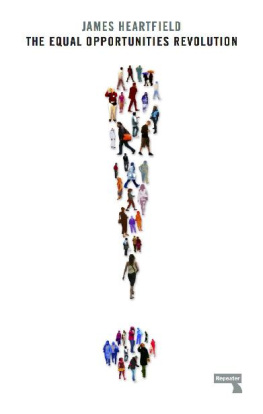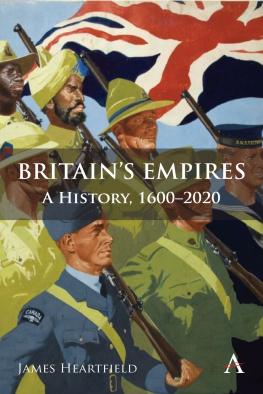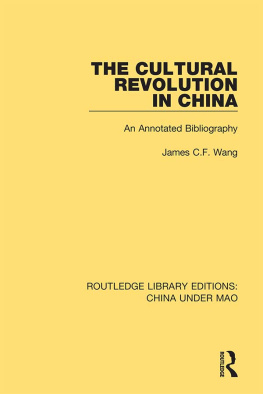James Heartfield - Equal Opportunities Revolution
Here you can read online James Heartfield - Equal Opportunities Revolution full text of the book (entire story) in english for free. Download pdf and epub, get meaning, cover and reviews about this ebook. year: 2017, publisher: Watkins Media Limited, genre: Politics. Description of the work, (preface) as well as reviews are available. Best literature library LitArk.com created for fans of good reading and offers a wide selection of genres:
Romance novel
Science fiction
Adventure
Detective
Science
History
Home and family
Prose
Art
Politics
Computer
Non-fiction
Religion
Business
Children
Humor
Choose a favorite category and find really read worthwhile books. Enjoy immersion in the world of imagination, feel the emotions of the characters or learn something new for yourself, make an fascinating discovery.
- Book:Equal Opportunities Revolution
- Author:
- Publisher:Watkins Media Limited
- Genre:
- Year:2017
- Rating:4 / 5
- Favourites:Add to favourites
- Your mark:
- 80
- 1
- 2
- 3
- 4
- 5
Equal Opportunities Revolution: summary, description and annotation
We offer to read an annotation, description, summary or preface (depends on what the author of the book "Equal Opportunities Revolution" wrote himself). If you haven't found the necessary information about the book — write in the comments, we will try to find it.
Equal Opportunities Revolution — read online for free the complete book (whole text) full work
Below is the text of the book, divided by pages. System saving the place of the last page read, allows you to conveniently read the book "Equal Opportunities Revolution" online for free, without having to search again every time where you left off. Put a bookmark, and you can go to the page where you finished reading at any time.
Font size:
Interval:
Bookmark:
The Equal Opportunities Revolution
The Equal Opportunities Revolution
James Heartfield

Contents
Preface
Somewhere between 1965 and 2005 British attitudes on race and sex discrimination went through a sea-change. Broadly, the common belief that white people were better than black people, and that men were better than women, was challenged. There are many sides to that challenge, but this book just looks at one, equal opportunities in the workplace. Before the 1970s there were no workplaces that had equal opportunities policies. Today, the great majority of people at work are covered by such a policy as they are covered by many acts of parliament drafted to guarantee equality at work.
There are a great many books written about diversity at work. Many of these are handbooks for employers and human resource managers, or they are addressed to employees and their representatives. As valuable as those are, they do not show the change that took place in the later part of the twentieth century. Talking to students about these questions many are generally aware that social attitudes in the past were very different. But it is harder for them to see how it was that things changed. The publications about discrimination at work do not address the question why equal opportunities policies arose, what the social conditions were that led to their success.
This book is written as a history, drawn from published sources. It also relies a lot on my own records and recollections of the time, and those of my peers. It is strange to see arguments that were only just developing when I was younger settle down to become the basis of policies and practices that govern society today. The questions of inequality were urgent as I was growing up, when the country was fixated on immigration, its supposed threat to jobs, and also on the growing numbers of women at work, and the imagined damage that would do to family life. As students we protested against discrimination I was thrown out of college after one occupation demanding nurseries for students with children. In the 1980s I worked at Haringey Council, which was at the centre of a great row with the government about equal opportunities for ethnic minorities, and then again about gay rights. The industrial struggles that were common in the 1970s carried on, right up to year-long miners strike against pit closures. But more and more, the argument in society was about oppression and discrimination, as well as about workers pay and conditions. I was only a bit-player in the culture wars of the 1980s, but they did unfold around me. The book draws on my experiences, and those of the many people alongside whom I worked and campaigned over questions of discrimination and workers rights over three decades. In particular I have leant on the advice and wisdom of Daniel Ben-Ami, Rosie Cuckston, Phil Hammond, Eve Kay, Chris Kyriakides, Kenan Malik, Munira Mirza, Mick Owens and Kevin Yuill. I am indebted too to Lizzie Terry and Tariq Goddard whose interest in this story helped the writing of it.
The book also draws on documents that I am embarrassed to think of now as historical sources, having seen them the first time around as so many surplus newsletters and policy briefs, often heading for the wastepaper bin. The work of the Commission for Racial Equality and the Equal Opportunities Commission, as well as the many local authority and employers working groups on equality, were not well-respected at the time. They were often seen by conservatives as social engineering and by radicals as tokenism both criticisms that had some point. When I contacted the press office of the Human Rights Commission they were unaware of any history of their predecessor commissions (though there are in fact some retrospective accounts, as in the 25th Annual Report of the CRE). In reconstructing their history, and that of the other local government and workplace bodies dealing with equal opportunities, my argument is that these organisations did have a greater impact than they are credited for, though the changes they heralded were also pushed forward by other changes in the way that work is organised.
Back then, many of us were pessimistic about the likelihood that the market system, capitalism, could be reformed, most especially in its dependence on discrimination against women and against black people. The case against oppression was one that seemed to demand a revolution against the whole social order. A revolution did take place, but not the one that we were hoping for. The revolution in workplace relations has been profound. It was a revolution that did not overthrow the market system, but instead perfected it. Many of the things that we thought were unlikely to happen under capitalism, like a general belief in equality between men and women, and even a general belief in equality between white and black, did happen. The discrimination that we thought was going to get worse, got better. But the improvement of the position of women relative to men, and of black people relative to white people, took place in the context of a worsening of the position of all working people, relative to their employers. The position of the working classes overall, which we hoped would get better, has gotten much worse. Trying to understand the contradictions of the equal opportunities revolution is what we set out to do here.
Introduction
Equal opportunities policies were first modelled in Britain in the early 1980s. In 1980, the Commission for Racial Equality listed 73 employers who had adopted their draft equal opportunities policy. By 2004, three quarters of all workplaces had a formal written equal opportunities policy, up from 64% in 1998.
Equal opportunities policies were designed to address discrimination against women and ethnic minorities at work. These are policies adopted by firms. They include promises not to discriminate, equal pay for equal work, oversight of recruitment policies and of promotions, and monitoring of the ethnic and gender mix of the workforce.
Before there were any such policies, there were laws against discrimination, notably the 1970 Equal Pay Act, the 1975 Sex Discrimination Act and the 1976 Race Relations Act (there were predecessors, and there have been reforms afterwards, but these are the most important). Both laws created quangos to enforce non-discrimination, which were known at the time as the Commission for Racial Equality and the Equal Opportunities Commission. Both had powers to investigate and to find against individual employers.
Though the EOC and the CRE were important enforcement bodies, the adoption of equal opportunities policies by firms signalled the dissemination and generalisation of a culture of equal opportunities. This is a sea change in British employment law and practice. Discrimination had been woven into the workplace to a remarkable degree in the later nineteenth and twentieth centuries.
Today women are nearly half the workforce, and the gender pay gap is shrinking all the time. Employers have taken on many more black people, too, and the racially segregated workplaces that were common up into the 1970s are today exceptional.
Catherine Hakim called this change an equal opportunities revolution, and she is right. Whatever problems remain, it is hard to gainsay that the explicit promises and beliefs of mainstream British society are for equality of opportunity. It is a revolution because oppression in the home, at the borders, and in the ghettos had been a mainstay of British society, and one that shaped the world of work. A gender and racial division of labour made a hierarchy in which women and migrants were marginal workers. That hierarchy is being dismantled. More importantly, it has no significant, explicit defenders among the political or business elite.
Next pageFont size:
Interval:
Bookmark:
Similar books «Equal Opportunities Revolution»
Look at similar books to Equal Opportunities Revolution. We have selected literature similar in name and meaning in the hope of providing readers with more options to find new, interesting, not yet read works.
Discussion, reviews of the book Equal Opportunities Revolution and just readers' own opinions. Leave your comments, write what you think about the work, its meaning or the main characters. Specify what exactly you liked and what you didn't like, and why you think so.









